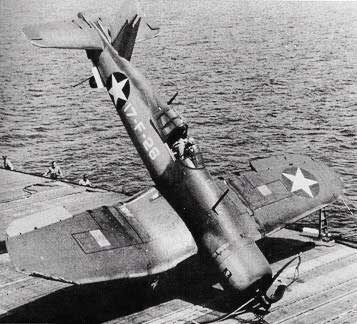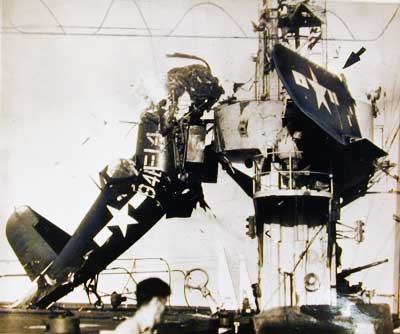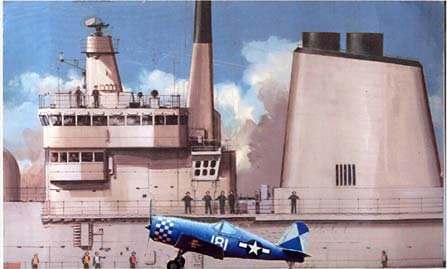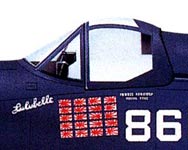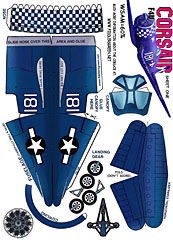
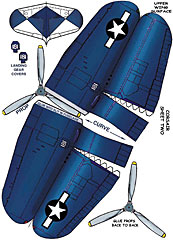
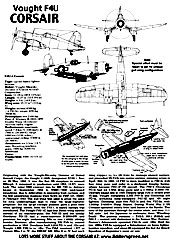
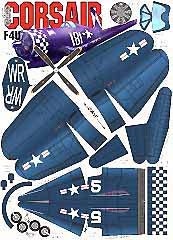
Vought-Corsair-F4U - $$7.50
The Vought F4U Corsair, at first, was unable to land on a carrier but with precise training along with new techniques it became possible. The unique 'gull' shaped wing provided clearance for the massive prop swung by a massive engine. This was a true hero in the WWII Pacific theatre. 1/13-56
Pappy Boyington
& the Chance Vought F4U Corsair
(includes Aircraft Carrier back ground shown below)
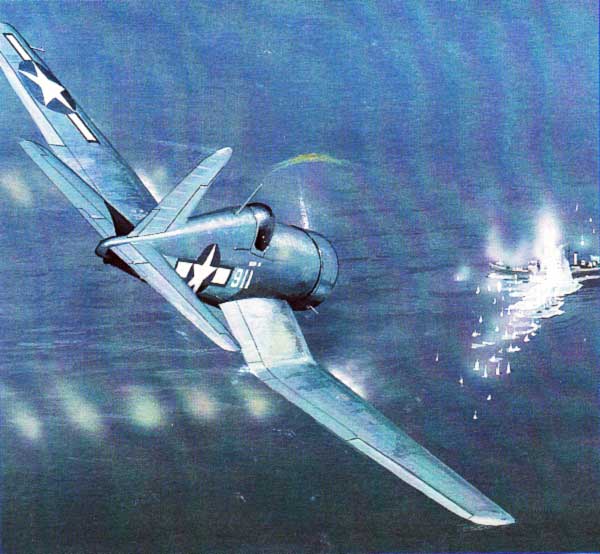
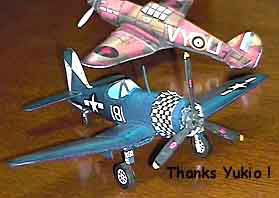
UNDENIABLY UNIQUE.. in appearance among single-seat fighters of its era, with its reverse-gulled wing, mighty Double Wasp engine and immense windmill of a propeller combining to impart an impression of brute strength, Chance Vought's F4U Corsair was not a comely airplane by any yardstick. There were those pilots that acclaimed it as the best single-seat fighter of any nation to emerge from WW II; there were pilots that pronounced it a vicious killer equally dispassionate towards killing its pilot as his opponent.
This is the Corsair F4U model that won the FG Modeling Madness (FGMM) 2010 best in class prize. |
|
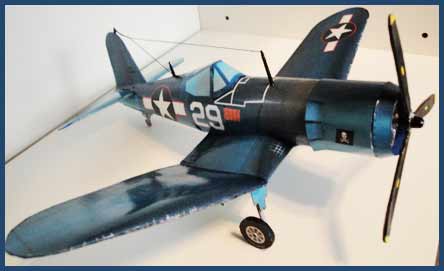 |
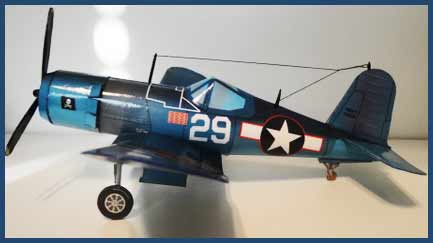 |
I chose the Corsair because I think it's one of the neatest of the WWII fighter aircraft. I live in a Navy town, and I guess I'm a bit prejudiced, but Navy aircraft are still my favorites. -Garland |
|
This is the one that will probably win the NEXT FGMM |
|
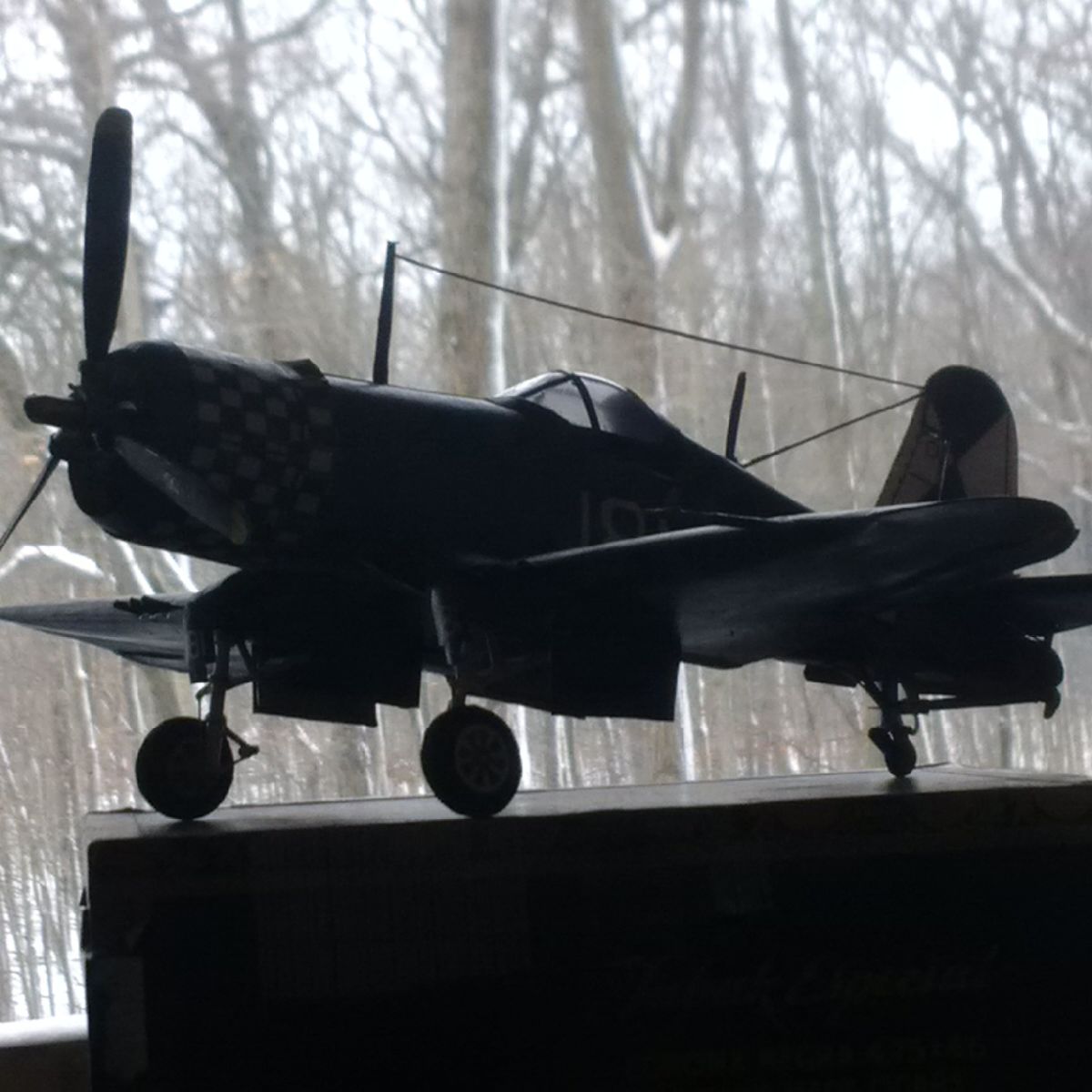 |
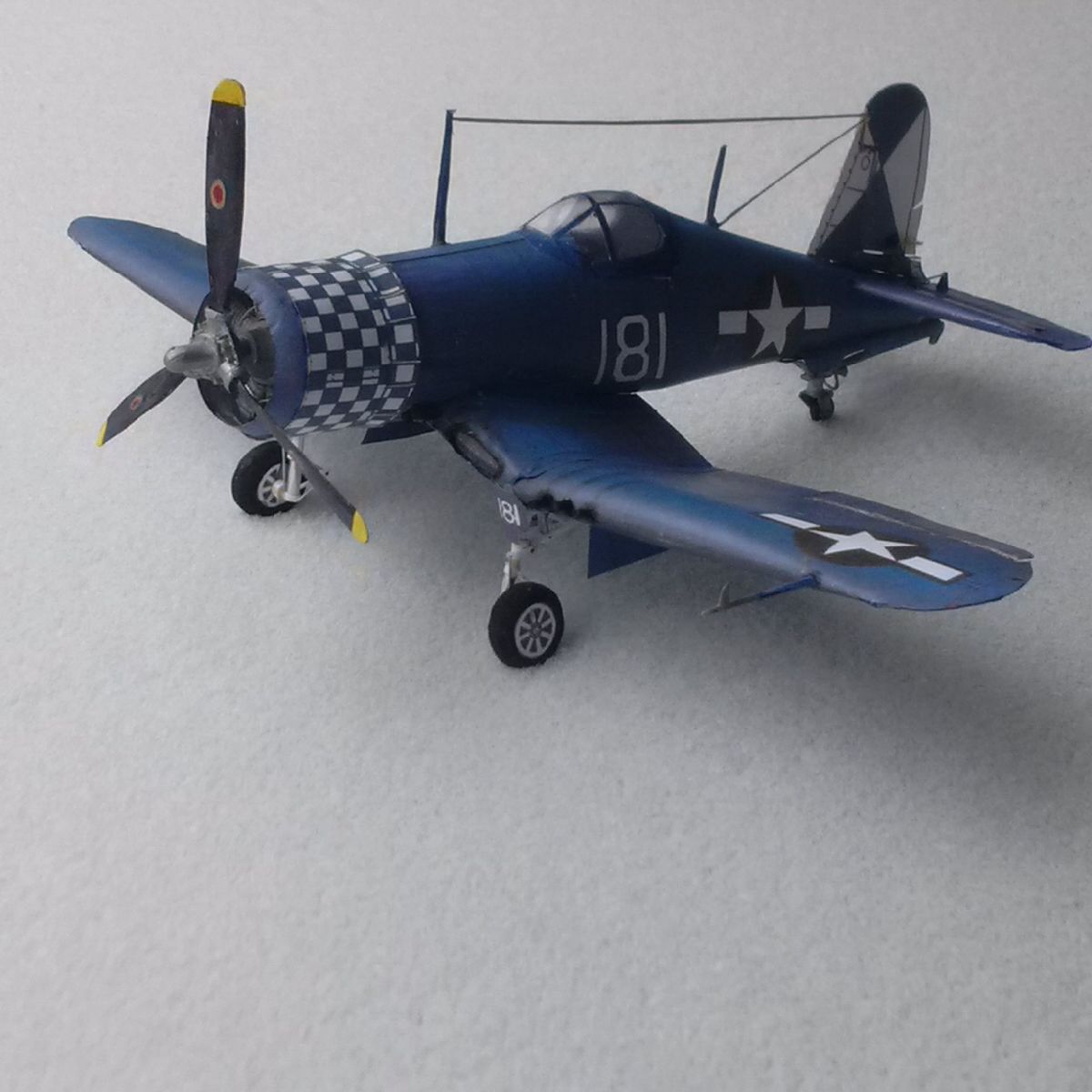 |
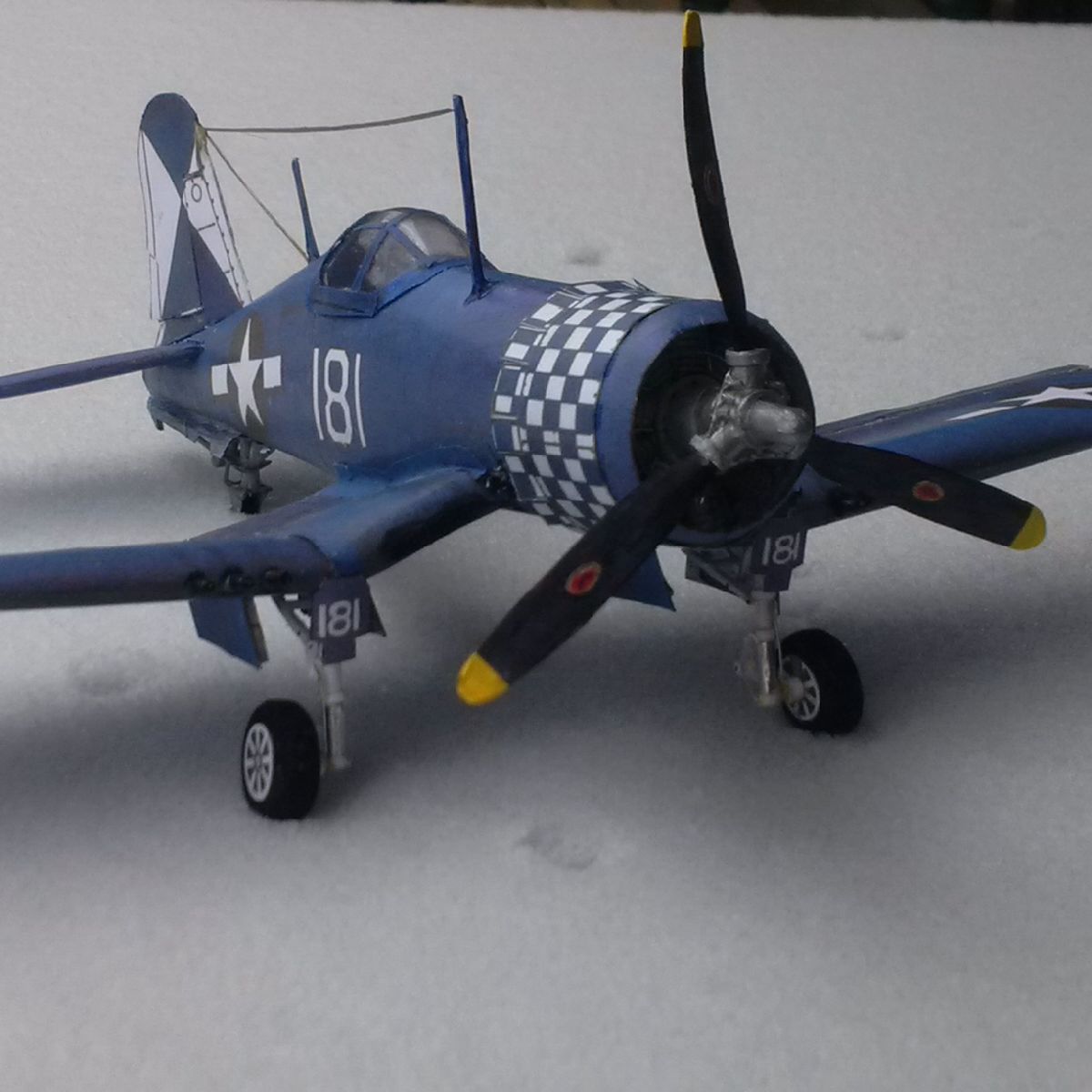 |
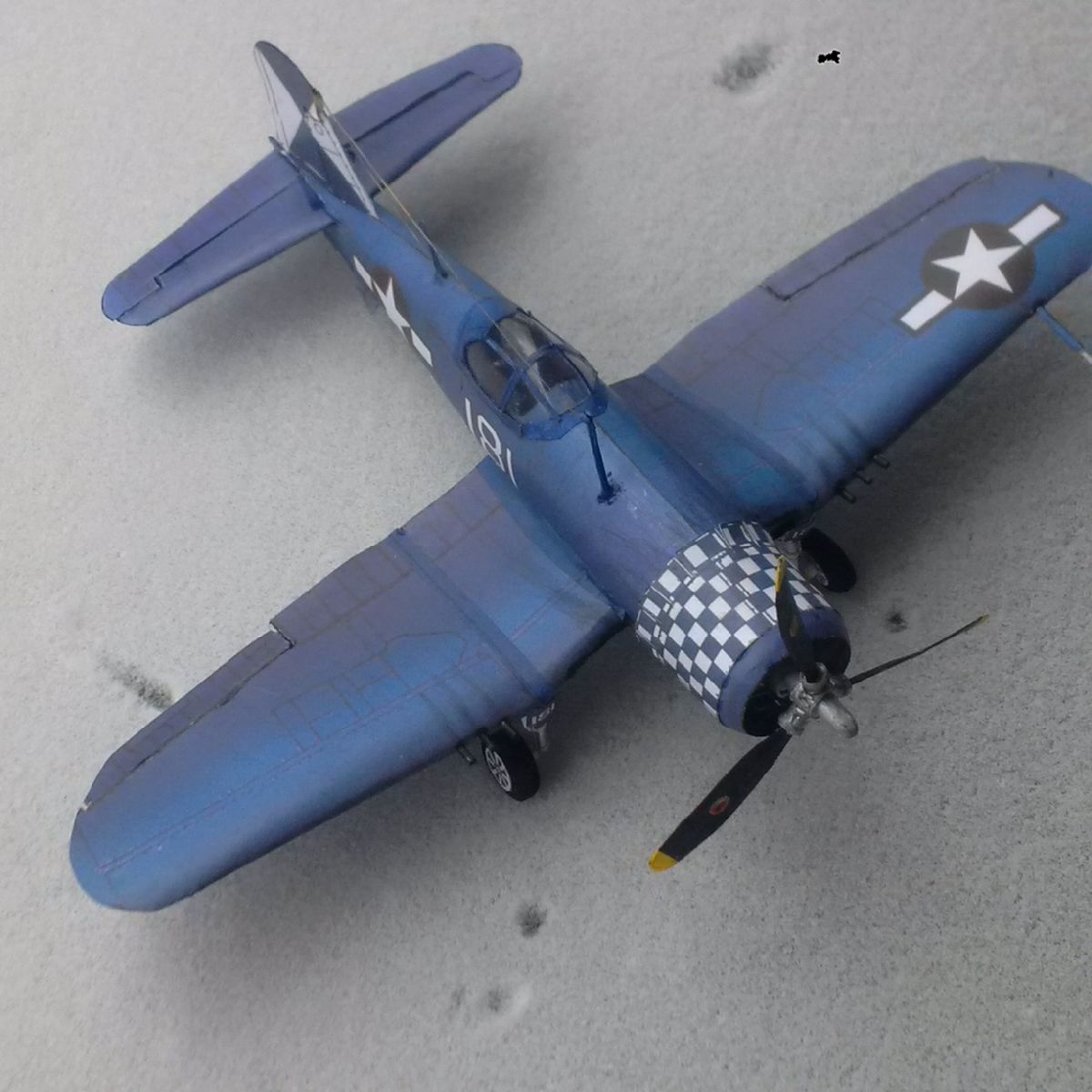 |
The bar has been raised. When you look at the model and it makes you want to fly the plane, then you know you've done a great job. - Scott Fyn |
|
What people say...
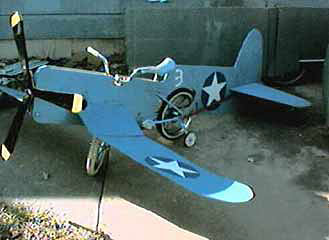
Dear Chip,
Do you remember me? I'm the bicycle float guy. I used your Corsair model on my Aircraft carrier in last year's Veteran's Day parade. Anyway, this year, i'm thinking... Hmm. If I get a broken hot-water-heater from my friends at the local recycling center, I wonder if I can copy my fiddler's green plane onto a transparency and project it onto a large piece pf paper on the wall, cut the paper out, and then start cutting the hot-water-heater. You haven't had anybody do this sort of thing and so know what problems to expect, have you? [Oh, I didn't think so.] If you have any ideas, please let me know.
Ok, here's a link to a poor photo of the parade floats from last year. In the background is the Carrier Essex. You can barely see your fiddler's green plane sitting on the top.
(My dad came up the evening I had set aside to make more FG planes, so we only had the one in the parade.)
My kids want a submarine, but I'm thinking: Hey, I already have a Corsair; let's make a Zero, and have a dogfight back and forth across the street during the parade. [Maybe I should save some smoke bombs from the 4th of July.Dan M (May 01)
Vought F4U Corsair
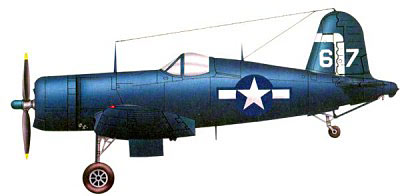
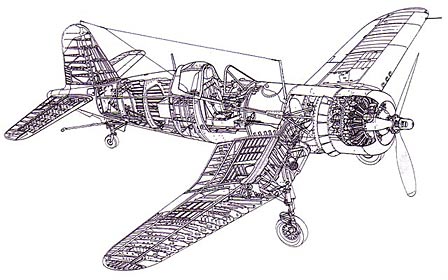 The Chance Vought F4U was in production longer than any other
US fighter of World War II, the Corsair had several
claims to fame. It was credited with an 11 :1 ratio of kills to
losses in action against Japanese aircraft and was the last piston
engine fighter in production for any of the US services.
The Chance Vought F4U was in production longer than any other
US fighter of World War II, the Corsair had several
claims to fame. It was credited with an 11 :1 ratio of kills to
losses in action against Japanese aircraft and was the last piston
engine fighter in production for any of the US services.
Its greatest attribute, though, was the excellence of its overall performance, making it certainly the finest carrier-based fighter of any used by the combatants in World War 11, and perhaps the best of any US fighters in that conflict.
Operational requirements for a new single-seat shipboard fighter were circulated to manufacturers by the US Navy early in 1938, and the Vought V-166B design, by a team led by Tex B. Beisel, was one of the proposals which resulted.
To obtain the very high performance specified-matching that of contemporary land-based fighters- Beisel designed the smallest possible airframe around the most powerful available engine, the Pratt & Whitney XR-2800 Double Wasp.
A characteristic feature of the Vought V-166B design was the inverted gull wing with the backward-retracting main legs of the landing gear located at the wing knuckles. This arrangement kept the legs short despite the height of the fuselage from the ground dictated by the large-diameter propeller. The wings folded upwards.
On June 30, 1938, the Vought company received a contract to build a single prototype of its Model V-1668, and this aircraft, designated XF4U-l, made its first flight on May 29, 1940. Powered by a 2,000 hp XR-2800-4 engine, the XF4U-I had a 030-in and a 050-in gun in the forward fuselage, one 050-in in each wing and compartments in the wings for 10 small bombs for use against bomber formations. Before the end of 1940 the XF4U-l had flown at 404 mph, faster than any US fighter then in the air, and on June 30, J 941, the Navy ordered production of 584 F4U-l s.
Deliveries of the Chance Vought F4U-ls began on October 3, 1942, four months after the first flight of the production Corsair, with the initial aircraft going to VF-12. Production aircraft had the R-2800-8 engine, two more guns in the wings with extra ammunition, self-sealing fuel tanks and armor protection: the cockpit was located 3 ft further aft to allow additional fuel to be carried in the fuselage.
This last-mentioned change adversely
affected the pilot's view, and carrier landing trials aboard the
USS Sangamon in September 1942 cast doubts about the aircraft's
suitability for the carrier role. Consequently,
F4U-ls were issued primarily to land-based Marine units, starting
with VMF-124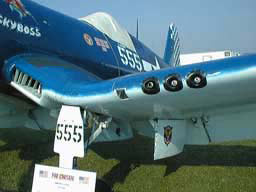 . This unit took the Corsair into operation for the
first time on February 13, 1943, at Bougainville, and seven more
Marine units were flying the Corsair by August 1943. A month later,
Navy Squadron VF-17, also land-based, became operational in New
Georgia.
. This unit took the Corsair into operation for the
first time on February 13, 1943, at Bougainville, and seven more
Marine units were flying the Corsair by August 1943. A month later,
Navy Squadron VF-17, also land-based, became operational in New
Georgia.
To speed production of the Corsair, contracts were placed with the Brewster and Goodyear companies for versions similar to the F4U-l, designated F3A-l and FG-l respectively and both incorporating a raised cockpit hood, which was introduced on the 689th F4U-l built by Vought; the FG-IA version had fixed wings.
Some Corsairs were fitted with four 20 mm cannon in the wings in place of the machine guns, and others for use as fighter-bombers had fittings for a long-range tank under the fuselage and two 1,000 lb bombs or eight 5-in rockets under the wings, and the R-2800-8W engines with water injection. Production of these initial Corsair versions totaled 4,120 F4U-ls by Vought.
2,012 Corsairs were supplied to Britain's Royal Navy under lend-lease, and another 370 went to the RNZAF. Operating from HMS Victorious, Corsair of No. 1834 Squadron of the Fleet Air Arm went into operation on April 3, 1944, during the attacks on the Tirpirz, this being the first time Corsairs had operated from aircraft carriers.
The US Navy was still reluctant to commit its F4Us to carrier operation, but in April 1944 a further series of trials by VF-301 on the USS Gahier Bay showed that no serious problems remained and approval was finally given for the Navy squadrons to take their aircraft to sea.
Work on a night-fighter version of the Corsair had begun as early as January 1942 when a prototype XF4U-2 was ordered. Design features included radar on the starboard wingtip and an autopilot.
Use of a turbo supercharged version of the Double Wasp engine was projected during 1941, and in March 1942 Vought received a contract for three XF4U-3s, including one F4U-l conversion. This work proceeded on low priority throughout the war, however, and the first XF4U-3 did not appear until 1946, with an R-2800-16 engine.
Twenty-seven similar FG-3s were ordered from Goodyear, but only 13 were completed. The second major production version of the Corsair, therefore, was the F4U-4, the prototype of which first flew on April 19, 1944, with a 2,100 hp R-2800-18W engine. The additional power from this engine increased the maximum speed of the F4U-4 to 446 mph, and other small changes were made to improve the operational characteristics of this version.
 Model diorama by Modeln' Pal, Dick Doll |
This gull winged Navy fighter was so surprisingly powerful that it took months before anyone was able figure out how to land it on a carrier...and then, have the guts to try! The characteristic gull wings are no trouble to assemble on this really fine little model. It was the plane that won the air war in the Pacific. |
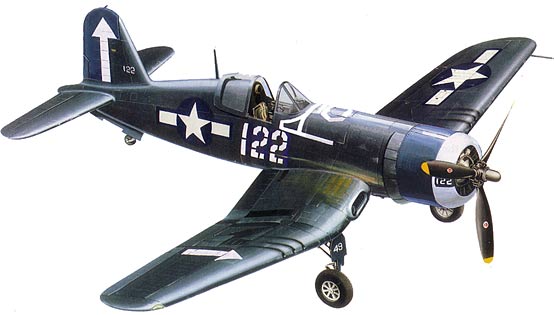
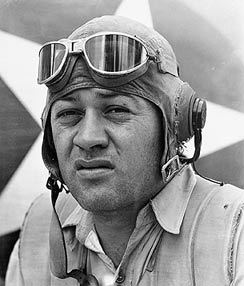 |
Pappy Boyington:
Stories of Pappy Boyington are legend, many
founded in fact, including how he led the legendary Black
Sheep squadron, and how he served in China as a member of
the American Volunteer Group, the famed Flying Tigers. He
spent a year and a half as a Japanese POW, was awarded the
Congressional Medal of Honor, was recognized as the Marine
Corps top ace. Always hard-drinking and hard-living, Pappy's
post-war life was as turbulent as his wartime experiences. |
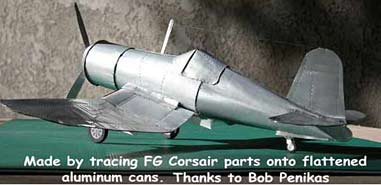 |
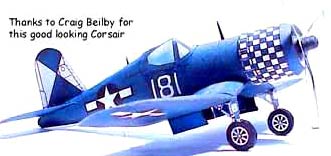 |
|
|
The only problem is that it was really nothing more than a "photo op." Boyington never flew #883 in combat. In fact, the Marine fliers during the Solomon's campaign flew any plane they could get. It wasn't like the Eighth Air Force in Europe, where each pilot had a personal plane and supporting crew. At the end of a thin supply line, largely dependent on Navy logistics, dedicating specific planes to specific pilots was a luxury the Marines just didn't have. Also, it's my speculation that the Marines, as a "Naval" service, followed the habits and customs of the senior service. The Navy pilots, operating from cramped carriers, always shared planes. |
|
|
||
Specifications for the Vought F4U Corsair
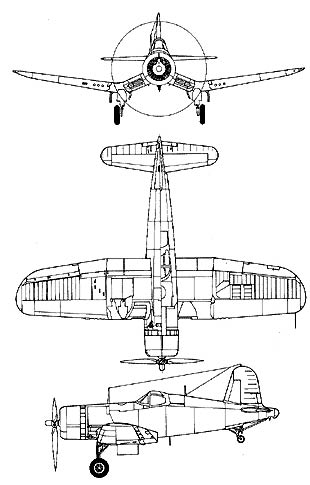 |
Length: 33 ft 4 in |
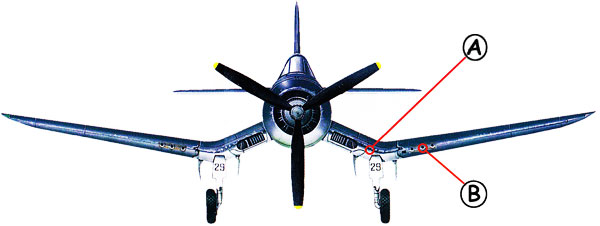 |
|
| A: The most instantly recognizable feature of the Corsair was it's inverted gull wing. In addition to giving the huge propeller extra ground clearance. it also ensured that the wing met the fuselage at right angles, causing minimum interference drag. | B: Early F4Us had the standard U.S. armament of six .50 caliber machine guns. Later variants carried four cannon. |
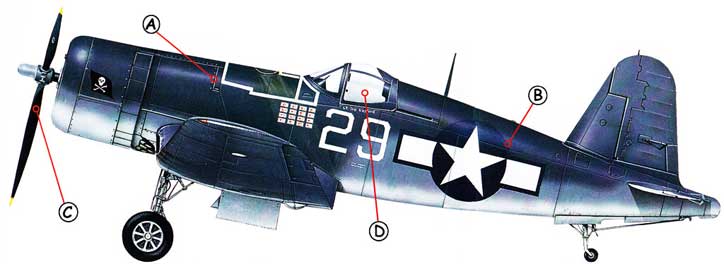 |
|||
| A: Much of the Corsair's long nose was occupied by a single self-sealing fuel tank holding 237 gallons. | B: Structure of the Corsair was conventional all-metal. although extensive spot welding rather than riveting gave it a smooth skin. | C: The 18-cylnder Pratt & Whitney Double Wasp engine drove a three-bladed Hamilton Standard propeller. At 13 feet in diameter, it was easily the biggest fitted to a fighter of the time. | D: The cockpit was set well back along the fuselage. Visibility ahead and down was poor, which contributed to the type's early carrier landing problems. |
